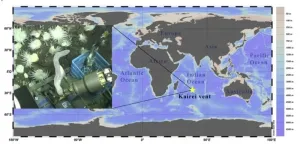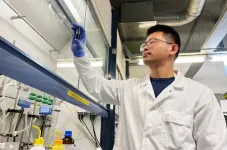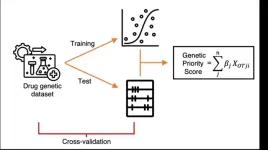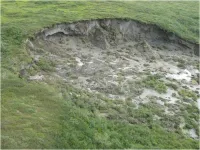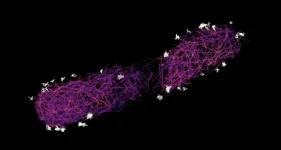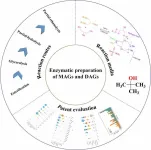(Press-News.org) Hydrothermal vents are an unlikely environment for animals to flourish, characterized by rapid changes in temperature and a challenging chemistry: acidic pH, rich in sulfur and methane. Not to mention the high hydrostatic pressure and the darkness of the deep sea. A team of scientists at the Sanya Institute of Deep-sea Science and Engineering (China) have now sequenced the full genome of a particularly unusual inhabitant of the hydrothermal vent environment: the sea cucumber Chiridota heheva. The research has been published in the Open Science journal GigaScience.
Organisms found at hydrothermal vents are among the most unique life forms on the planet, as they evolved special adaptations to survive and procreate under these harsh conditions. For example, many microbes employ special metabolic functions to deal with the abundance of sulfur and iron, and to withstand the enormous heat near the vent. In addition to microbes, there are even multicellular and higher order organisms that have adapted to the hydrothermal vent conditions, including various species of worms, snails, crabs and shrimp.
In 2019, a Chinese deep sea expedition with the manned research submarine “Shenhaiyongshi” collected a specimen of the sea cucumber C. hehevae at the bottom of the Indian Ocean, at the Kairei vent field at a depth of 2,428 meters. The water around the Kairei vent is particularly enriched in dissolved iron, adding to the harsh conditions of high hydrostatic pressure, darkness and fluctuating temperatures.
Sea cucumbers are echinoderms, and as such related to sea urchins and sea stars - a group of animals with highly unusual body plans. They are found on sea floors all over the world, where they devour detritus and use their tentacle to explore the sediment. While other high-quality genomes of sea cucumbers are available, the work now presented in GigaScience is the first genome of a sea cucumber specimen collected at a hydrothermal vent.
Initial comparative genome analyses indicate that several gene families are expanded in this sea cucumber, meaning that the species has a higher repertoire of specific sets of genes than related species. These expanded and unique genes are involved in DNA repair and iron metabolism, among other processes - a first indication that the adaptations to the harsh, iron-rich environment are reflected in the species’ genome. The genomic data will provide a valuable resource for further studies on both, sea cucumbers and the unique vent fauna.
Further Reading:
Pu Y, Zhou Y, Liu J, Zhang H
A high-quality chromosomal genome assembly of the sea cucumber Chiridota heheva and its hydrothermal adaptation. Gigascience 2023 giad107 https://doi.org/10.1093/gigascience/giad107
URL: https://academic.oup.com/gigascience/article-lookup/doi/10.1093/gigascience/giad107
Data Availability:
Pu Y; Zhou Y; Liu J; Zhang H (2023): Supporting data for "A high-quality chromosomal genome assembly of the sea cucumber Chiridota heheva and its hydrothermal adaptation" GigaScience Database. http://dx.doi.org/10.5524/102481
Sharing on social media?
Find GigaScience online on twitter: @GigaScience, @GigabyteJournal, @Giga_DB. On BlueSky: @gigascience.bsky.social. On Facebook: https://www.facebook.com/GigaScience, and keep up-to-date with our blog http://gigasciencejournal.com/blog
About GigaScience Press
GigaScience Press is BGI's Open Access Publishing division, which publishes scientific journals and data. Its publishing projects are carried out with international publishing partners and infrastructure providers, including Oxford University Press and River Valley Technologies. It currently publishes two award-winning data-centric journals: its premier journal GigaScience (launched in 2012), which won the 2018 American Publishers PROSE award for innovation in journal publishing, and its new journal GigaByte (launched 2020), which won the 2022 ALPSP Award for Innovation in Publishing. The press also publishes data, software, and other research objects via its GigaDB.org database. To encourage transparent reporting of scientific research and to enable future access and analyses, it is a requirement of manuscript submission to all GigaScience Press journals that all supporting data and source code be made openly available in GigaDB or in a community approved, publicly available repository.
About GigaScience
GigaScience is co-published by GigaScience Press and Oxford University Press. Winner of the 2018 PROSE award for Innovation in Journal Publishing (Multidisciplinary), the journal covers research that uses or produces 'big data' from the full spectrum of the biological and biomedical sciences. It also serves as a forum for discussing the difficulties of and unique needs for handling large-scale data from all areas of the life and medical sciences. The journal has a completely novel publication format -- one that integrates manuscript publication with complete data hosting, and analyses tool incorporation. To encourage transparent reporting of scientific research as well as enable future access and analyses, it is a requirement of manuscript submission to GigaScience that all supporting data and source code be made available in the GigaScience database, GigaDB, as well as in publicly available repositories. GigaScience will provide users access to associated online tools and workflows, and has integrated a data analysis platform, maximizing the potential utility and re-use of data.
About GigaDB:
GigaDB is a data repository supporting scientific publications in the Life/Biomedical Sciences domain. GigaDB organizes and curates data from individually publishable units into datasets, which are openly available as FAIR data. GigaDB primarily serves as a repository to host data, tools, and other research objects that underlie the research in the article, and also data from articles from other journals in approved cases. Through association with DataCite, each dataset in GigaDB is assigned a DOI that can be used as a standard citation for future use of these data in other articles by the authors and other researchers. To maximize utility for the research community, all datasets in GigaDB are placed under a CC0 waiver. However, for data that needs to be protected, GigaDB will include the contact information for access, the restrictions for use, and host the application form needed to gain permission for use. The protected databases must be persistent and internationally accessible.
Media contacts:
GigaScience, Editor-in-Chief:
Scott Edmunds, Scott@gigasciencejournal.com, Cell: +852 92490853
END
Some sea cucumbers like it hot
The genome of a sea cucumber, collected at a depth of 2400 m during a submarine trip to a hydrothermal vent, sheds light on genetic features that help marine animals to survive in extreme conditions
2024-01-03
ELSE PRESS RELEASES FROM THIS DATE:
New reasons eating less fat should be one of your resolutions
2024-01-03
A UC Riverside study to motivate your new year’s resolutions: it demonstrates that high-fat diets affect genes linked not only to obesity, colon cancer and irritable bowels, but also to the immune system, brain function, and potentially COVID-19 risk.
While other studies have examined the effects of a high-fat diet, this one is unusual in its scope. UCR researchers fed mice three different diets over the course of 24 weeks where at least 40% of the calories came from fat. Then, they looked not only at the microbiome, but also at genetic changes in all four parts of the intestines.
One group of ...
Job ads with wide pay ranges can deter applicants
2024-01-03
PULLMAN, Wash. – As more states require employers to list compensation on job ads, a trending strategy to use very wide pay ranges could potentially harm recruitment, according to a Washington State University study.
The study, published in the Journal of Applied Psychology, found that participants in three different experiments were more likely to respond negatively to job ads with very wide pay ranges, viewing those employers as less trustworthy. Prior surveys have found that most people report they would trust organizations that include pay ranges in ...
What makes urine yellow? UMD scientists discover the enzyme responsible
2024-01-03
Researchers at the University of Maryland and National Institutes of Health have identified the microbial enzyme responsible for giving urine its yellow hue, according to a new study published in the journal Nature Microbiology on January 3, 2024.
The discovery of this enzyme, called bilirubin reductase, paves the way for further research into the gut microbiome’s role in ailments like jaundice and inflammatory bowel disease.
“This enzyme discovery finally unravels the mystery behind urine’s yellow color,” said the study’s lead author Brantley Hall, an assistant ...
Non-toxic quantum dots pave the way towards CMOS shortwave infrared image sensors for consumer electronics
2024-01-03
Invisible to our eyes, shortwave infrared (SWIR) light can enable unprecedented reliability, function and performance in high-volume, computer vision first applications in service robotics, automotive and consumer electronics markets. Image sensors with SWIR sensitivity can operate reliably under adverse conditions such as bright sunlight, fog, haze and smoke. Furthermore, the SWIR range provides eye-safe illumination sources and opens up the possibility of detecting material properties through molecular imaging.
Colloidal quantum ...
Complex, unfamiliar sentences make the brain’s language network work harder
2024-01-03
CAMBRIDGE, MA -- With help from an artificial language network, MIT neuroscientists have discovered what kind of sentences are most likely to fire up the brain’s key language processing centers.
The new study reveals that sentences that are more complex, either because of unusual grammar or unexpected meaning, generate stronger responses in these language processing centers. Sentences that are very straightforward barely engage these regions, and nonsensical sequences of words don’t do much for them either.
For ...
Novel genetic priority score unveiled to enhance target prioritization in drug development
2024-01-03
New York, NY [January 3, 2024]—Driven by the need for a better way to prioritize targets for drug development, the Icahn School of Medicine at Mount Sinai has led the development of a novel “genetic priority score” (GPS) that will integrate various types of human genetic data into a single easy-to-interpret score.
The findings were described in the January 3 online issue of Nature Genetics [DOI: 10.1038/s41588-023-01609-2].
Studies have shown that drugs have an increased likelihood of success in clinical trials when ...
Microbial awakening restructures high-latitude food webs as permafrost thaws
2024-01-03
Alaska is on the front lines of climate change, experiencing some of the fastest rates of warming of any place in the world. And when temperatures rise in the state’s interior—a vast high-latitude region spanning 113 million acres—permafrost there not only thaws, releasing significant amounts of its stored carbon back into the atmosphere where it further accelerates rising temperatures, but it decays. This decomposition has the potential to infuse above- and belowground food webs with carbon, which can affect ...
Bacteria load their syringes
2024-01-03
Disease-causing bacteria of the genus Salmonella or Yersinia can use tiny injection apparatuses to inject harmful proteins into host cells, much to the discomfort of the infected person. However, it is not only with a view to controlling disease that researchers are investigating the injection mechanism of these so-called type III secretion systems, also known as "injectisomes".
If the structure and function of the injectisome were fully understood, researchers would be able to hijack it to deliver specific drugs into cells, such as cancer cells. In fact, the structure of the injectisome has already been elucidated. ...
Greener and feasible production: Enzymatic methods for mono- and diacylglycerol synthesis in the food industry
2024-01-03
MAGs, predominantly in 1(3)-MAG form, and DAGs, with 1,3-DAGs as the more stable isomer, are crucial in food, cosmetic, and other industries. While MAGs are vital emulsifiers, comprising 75% of global production, DAGs are known as functional cooking oils that can reduce body fat and serum TAGs. However, their natural concentration in oils is low, prompting extensive research into their chemical and environmentally-friendly enzymatic production.
Recently, a review published in the Grain & Oil Science and Technology journal on 2 November 2023, has shed light on the advancements in enzymatic production methods with special efforts on practical and ...
Re-calibrating the sail plan for Native Hawaiians, Pacific Islanders in ocean sciences
2024-01-03
In Hawaiʻi and across much of Oceania, Pacific Islanders celebrate the connections between their islands and the ocean that surrounds them. “As descendants of the ocean, the dearth of Native Hawaiians and Pacific Islanders (NHPI) in ocean science seems inconsonant,” writes a team of authors that includes University of Hawai‘i (UH) at Mānoa faculty, students, and alumni in an article in a special issue of the journal Oceanography, “Building Diversity, Equity, and Inclusion in the Ocean Sciences. The authors ask, “Where are all our island people in the ...
LAST 30 PRESS RELEASES:
Becoming human in southern Africa: What ancient hunter-gatherer genomes reveal
The transformation of adult heart transplantation in the United States and Western Europe
American Physical Society launches APS Open Science to expand global participation in trusted physics research
Family dogs boost adolescent mental health through the microbiome
Prehab can improve recovery after surgery, but barriers remain
Ten-thousand-year-old genomes from southern Africa change picture of human evolution
NeuMap: a pioneering map of neutrophils that redefines their role in health, infection, and inflammation
KATRIN tightens the net around the elusive sterile neutrino
Antipsychotic medication use by older adults
Statewide analysis quantifies life-saving potential of stop the bleed
Complex life developed earlier than previously thought, new study reveals
Semaglutide and early-stage metabolic abnormalities in individuals with schizophrenia spectrum disorders
Robert Wood Johnson University Hospital and Rutgers Robert Wood Johnson Medical School receive National Rare Disease Center of Excellence recognition
The Mohn Prize for 2026 awarded to Canadian John Smol
Americans more likely to accept guidance from AMA than CDC on vaccine safety
How two Russian scientists changed the way we understand aging and cancer
Noninvasive imaging could replace finger pricks for people with diabetes
Genome Research publishes a special issue on advances in computational biology and their applications in genomics
Announcing the 2025 Glenn Foundation for Medical Research Discovery Awards: Christina Camell, PhD (University of Minnesota) and Elaine Fuchs, PhD (The Rockefeller University)
Groundbreaking simulations show how black holes glow bright
When schizophrenia meets a personality disorder: why more research is urgently needed
SwRI may have solved a mystery surrounding Uranus’ radiation belts
Anna Gloyn wins 2026 Transatlantic Alliance Award in Endocrinology
FAU study finds connection between poor mental health and dark web use
A new study finds high-narcissism CEOs pursue more acquisitions in response to strong firm performance
During times of market volatility, investors should track insider trades
Fish freshness easily monitored with a new sensor
Antibiotics could trigger immune response through gut microbiome metabolites
New Family Heart Foundation study finds only 13% of adults with cardiovascular disease achieve comprehensive LDL-C management
UT San Antonio physicists' groundbreaking discoveries open new paths to combating diseases
[Press-News.org] Some sea cucumbers like it hotThe genome of a sea cucumber, collected at a depth of 2400 m during a submarine trip to a hydrothermal vent, sheds light on genetic features that help marine animals to survive in extreme conditions
